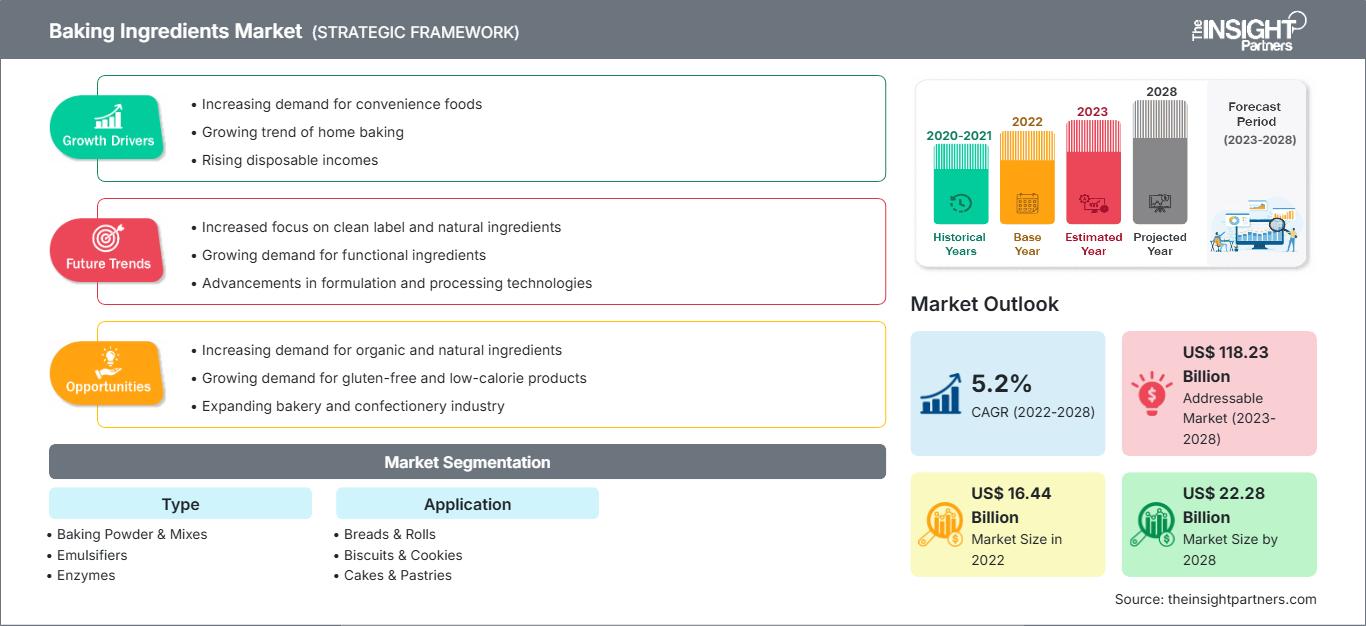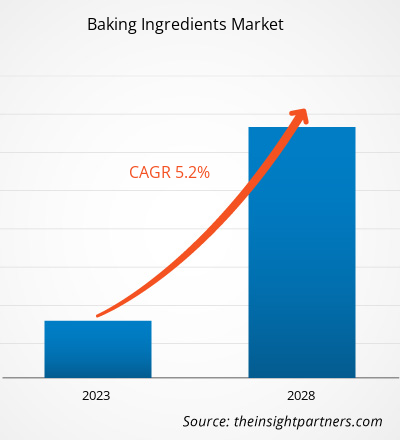Le marché des ingrédients de boulangerie devrait atteindre 22 278,10 millions de dollars américains d'ici 2028, contre 16 444,97 millions de dollars américains en 2022 ; il devrait croître à un TCAC de 5,2 % entre 2022 et 2028.
Les ingrédients de boulangerie comprennent les farines et les prémélanges, les édulcorants, les agents de croissance, la levure, les matières grasses, les émulsifiants, les matières grasses, les enzymes, les arômes, les colorants et les inclusions. Ces ingrédients jouent un rôle spécifique dans la qualité des produits de boulangerie. Par exemple, la levure donne du volume aux aliments cuits au four et les rend moelleux, légers et aérés. Les matières grasses et les matières grasses améliorent la texture et la force de la pâte. Les arômes et les colorants rehaussent le goût et l'attrait visuel des produits de boulangerie. La demande croissante de produits de boulangerie, notamment de gâteaux, de biscuits et de pâtisseries, due à la tendance croissante à la gourmandise, stimule la croissance du marché des ingrédients de boulangerie.
Le marché des ingrédients de boulangerie au Moyen-Orient et en Afrique devrait connaître la croissance la plus rapide au cours de la période de prévision. La région a connu une évolution socio-économique due à la rapidité du développement économique et à la hausse des revenus disponibles. De plus, l'urbanisation galopante, le mode de vie moderne et l'augmentation des dépenses ont modifié les habitudes d'achat et de consommation alimentaire. L'influence croissante de la culture occidentale, notamment chez les jeunes, transforme les habitudes de consommation. On observe une préférence croissante pour les produits alimentaires prêts à consommer sur le pouce. La demande de produits de boulangerie augmente en raison de leur accessibilité et de leur facilité de consommation. Ces facteurs contribuent à la croissance de l'industrie de la boulangerie, stimulant ainsi la croissance du marché des ingrédients de boulangerie au Moyen-Orient et en Afrique.
Personnalisez ce rapport en fonction de vos besoins
Vous bénéficierez d’une personnalisation sur n’importe quel rapport - gratuitement - y compris des parties de ce rapport, ou une analyse au niveau du pays, un pack de données Excel, ainsi que de profiter d’offres exceptionnelles et de réductions pour les start-ups et les universités
Marché des ingrédients de boulangerie: Perspectives stratégiques

-
Obtenez les principales tendances clés du marché de ce rapport.Cet échantillon GRATUIT comprendra une analyse de données, allant des tendances du marché aux estimations et prévisions.
Impact de la pandémie de COVID-19 sur le marché des ingrédients de boulangerie
Le secteur de l'alimentation et des boissons a été confronté à des défis inattendus dans le contexte de la pandémie de COVID-19. Diverses restrictions imposées par les gouvernements, telles que les confinements, les arrêts de production, les interdictions de voyager et les restrictions aux frontières, ont perturbé les chaînes d'approvisionnement mondiales en 2020. Cela a entraîné une pénurie de matières premières et de main-d'œuvre, ce qui a entravé la production de divers fabricants d'aliments et de boissons à petite et grande échelle. Cependant, pendant la pandémie de COVID-19, il y a eu une demande importante de produits de boulangerie tels que les gâteaux, les biscuits et les pâtisseries de la part des personnes confinées à la maison, car elles percevaient ces produits comme un bon moyen de surmonter le stress lié à la pandémie, ce qui a stimulé les ventes de produits de boulangerie et d'ingrédients de boulangerie. De plus, après le début de l'épidémie de COVID-19, les gens sont devenus plus préoccupés par leur santé et leur immunité. Par conséquent, ils remplacent les produits de boulangerie conventionnels par des produits fonctionnels tels que les produits biologiques, sans gluten, sans OGM, végétaliens et enrichis. Ce facteur devrait offrir des opportunités de croissance rentables au marché des ingrédients de boulangerie pour les produits fonctionnels au cours de la période de prévision.
Aperçu du marché : La demande croissante d'ingrédients fonctionnels offrira des opportunités lucratives aux acteurs du marché des ingrédients de boulangerie
Les consommateurs recherchent activement les bienfaits pour la santé des produits alimentaires qu'ils consomment. Dans le contexte de l'épidémie de COVID-19, ils sont devenus plus soucieux de leur santé et préfèrent les produits offrant des avantages fonctionnels. Par conséquent, ils ont tendance à remarquer la valeur nutritionnelle des produits de boulangerie, ce qui les attire vers des produits contenant des ingrédients plus sains, tels que des fibres, des probiotiques, des protéines végétales et une faible teneur en sucre. De nombreux consommateurs augmentent leur consommation de fibres pour gérer leur poids et favoriser leur santé digestive. Par conséquent, les fabricants de produits de boulangerie utilisent des ingrédients riches en fibres, tels que les farines complètes, pour répondre à la demande de produits de boulangerie riches en fibres, tels que les biscuits digestifs, les cookies riches en fibres et le pain complet. De plus, la demande d'édulcorants naturels tels que le miel, le sucre de coco et le sirop d'érable a considérablement augmenté. Ces édulcorants ont une valeur calorique inférieure à celle du sucre de table et offrent une saveur et une texture similaires à celles des produits de boulangerie. Ainsi, la demande croissante d'ingrédients fonctionnels dans les produits de boulangerie devrait ouvrir de nouvelles opportunités sur le marché des ingrédients de boulangerie au cours de la période de prévision.
Aperçu des types
Selon le type, le marché des ingrédients de boulangerie est classé en poudres et mélanges de boulangerie, émulsifiants, enzymes, amidons, colorants et arômes, huiles, matières grasses et matières grasses, entre autres. Le segment des enzymes devrait enregistrer le TCAC le plus élevé au cours de la période de prévision. Les enzymes jouent un rôle essentiel dans la fabrication des produits de boulangerie. Ils augmentent la durée de conservation des produits de boulangerie, éliminant ainsi le recours à des conservateurs chimiques ou artificiels. Les différentes enzymes utilisées dans le secteur de la boulangerie sont l'amylase, l'oxydase et la protéase, entre autres.
Aperçu des applications
En fonction des applications, le marché des ingrédients de boulangerie est segmenté en pains et petits pains, biscuits et cookies, gâteaux et pâtisseries, entre autres. Le segment des pains et petits pains représentait la plus grande part de marché en 2021. Les pains et petits pains comprennent la baguette, le pain au levain, le pain à la levure, la brioche, la focaccia et le pain ciabatta. Les préférences des consommateurs évoluent de jour en jour, et le besoin d'un produit de haute qualité stimule l'expansion des pains et petits pains sains.
Les principaux acteurs du marché des ingrédients de boulangerie sont Cargill, Incorporated ; ADM ; Associated British Foods Plc. ; Koninklijke DSM NV ; Kerry Group Plc ; AAK AB ; British Bakels ; Corbion ; International Flavors & Fragrances Inc. et Dawn Food Products Inc., entre autres. Ces entreprises proposent une large gamme d'ingrédients de boulangerie. Elles sont présentes dans les pays développés et en développement. Les principaux acteurs du marché se concentrent sur le développement de produits innovants et de haute qualité pour répondre aux exigences des clients.
Marché des ingrédients de boulangerie
Les tendances régionales et les facteurs influençant le marché des ingrédients de boulangerie tout au long de la période de prévision ont été analysés en détail par les analystes de The Insight Partners. Cette section aborde également les segments et la géographie du marché des ingrédients de boulangerie en Amérique du Nord, en Europe, en Asie-Pacifique, au Moyen-Orient et en Afrique, ainsi qu'en Amérique du Sud et en Amérique centrale.Portée du rapport sur le marché des ingrédients de boulangerie| Attribut de rapport | Détails |
|---|---|
| Taille du marché en 2022 | US$ 16.44 Billion |
| Taille du marché par 2028 | US$ 22.28 Billion |
| TCAC mondial (2022 - 2028) | 5.2% |
| Données historiques | 2020-2021 |
| Période de prévision | 2023-2028 |
| Segments couverts |
By Type
|
| Régions et pays couverts |
Amérique du Nord
|
| Leaders du marché et profils d'entreprises clés |
|
Densité des acteurs du marché des ingrédients de boulangerie : comprendre son impact sur la dynamique commerciale
Le marché des ingrédients de boulangerie connaît une croissance rapide, porté par une demande croissante des utilisateurs finaux, due à des facteurs tels que l'évolution des préférences des consommateurs, les avancées technologiques et une meilleure connaissance des avantages du produit. Face à cette demande croissante, les entreprises élargissent leur offre, innovent pour répondre aux besoins des consommateurs et capitalisent sur les nouvelles tendances, ce qui alimente la croissance du marché.
- Obtenez le Marché des ingrédients de boulangerie Aperçu des principaux acteurs clés
Points forts du rapport
- Tendances progressives du secteur sur le marché des ingrédients de boulangerie pour aider les entreprises à développer des stratégies efficaces à long terme
- Stratégies de croissance des entreprises adoptées par les acteurs du marché dans les pays développés et en développement
- Analyse quantitative du marché de 2020 à 2028
- Estimation de la demande mondiale d'ingrédients de boulangerie
- Analyse des cinq forces de Porter pour illustrer l'efficacité des acheteurs et des fournisseurs sur le marché des ingrédients de boulangerie
- Évolutions récentes pour comprendre le scénario concurrentiel du marché
- Tendances et perspectives du marché, et facteurs régissant la croissance du marché des ingrédients de boulangerie
- Aide au processus décisionnel en mettant en évidence les stratégies de marché qui sous-tendent l'intérêt commercial
- Taille du marché des ingrédients de boulangerie à différents nœuds
- Aperçu détaillé du marché et segmentation, et dynamique du secteur des ingrédients de boulangerie
- Taille du marché des ingrédients de boulangerie dans différentes régions avec des opportunités de croissance prometteuses
- Analyse historique (2 ans), année de base, prévision (7 ans) avec TCAC
- Analyse PEST et SWOT
- Taille du marché Valeur / Volume - Mondial, Régional, Pays
- Industrie et paysage concurrentiel
- Ensemble de données Excel
Rapports récents
Témoignages
Raison d'acheter
- Prise de décision éclairée
- Compréhension de la dynamique du marché
- Analyse concurrentielle
- Connaissances clients
- Prévisions de marché
- Atténuation des risques
- Planification stratégique
- Justification des investissements
- Identification des marchés émergents
- Amélioration des stratégies marketing
- Amélioration de l'efficacité opérationnelle
- Alignement sur les tendances réglementaires






















 Obtenez un échantillon gratuit pour - Marché des ingrédients de boulangerie
Obtenez un échantillon gratuit pour - Marché des ingrédients de boulangerie